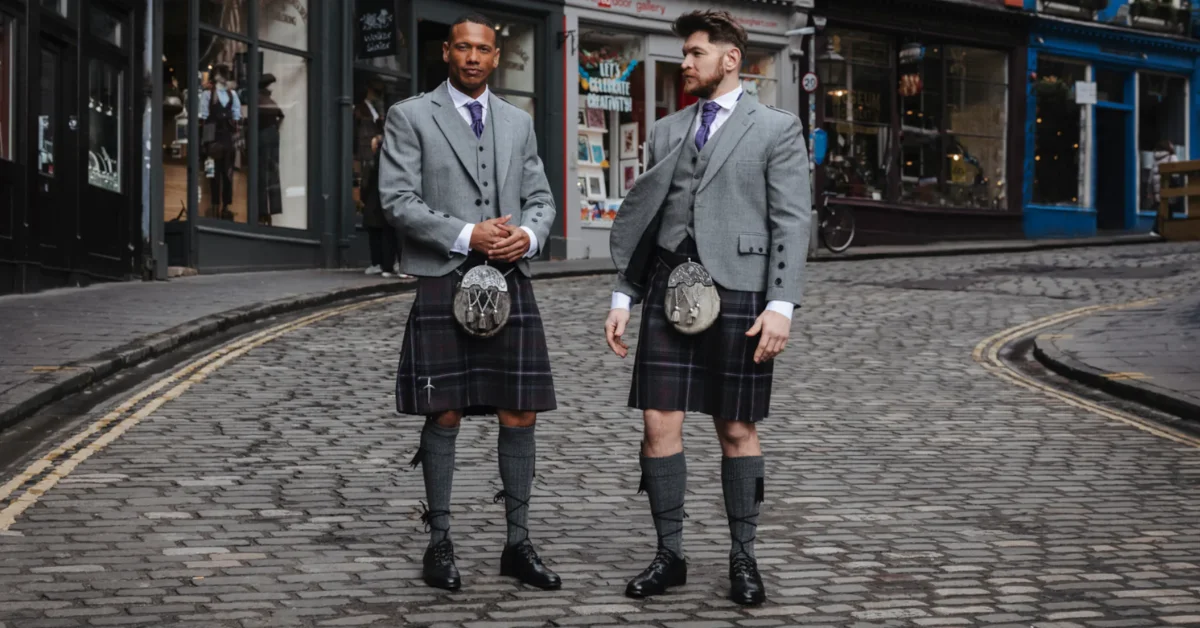Kilts, the iconic Scottish garments, are knee-length skirts traditionally made from tartan fabric. The word “kilt” itself evokes images of Scottish heritage, bagpipes, and rolling hills. These garments, with their distinctive patterns, have a timeless appeal that extends far beyond their origin. The history of kilts is deeply embedded in the Scottish Highlands, dating back to the 16th century. Initially conceived for practicality, allowing freedom of movement in challenging terrains, kilts became more than just clothing—they became symbols of clan identity and pride. Understanding this historical backdrop is crucial to appreciating the enduring allure of kilts.
Evolution of Kilts
Traditional Scottish kilts, adorned with tartan patterns representing different clans, continue to be revered. Worn with a sporran and knee-high socks, these kilts are a testament to the rich cultural tapestry of Scotland. The meticulous craftsmanship and attention to detail in traditional kilts make them more than garments; they are living artifacts of history. In the contemporary landscape, kilts have undergone a fascinating evolution. From leather kilts to utility kilts, the variety available today caters to a global audience. Modern wearers, while respecting tradition, appreciate the versatility of kilts in different materials and styles. This evolution is a testament to the enduring adaptability of kilts in the face of changing fashion trends.
Kilts in the News
Kilts have found themselves in the spotlight of recent events, capturing the imagination of news outlets globally. From high-profile ceremonies to unexpected viral moments, Kilts are making headlines for more than just their traditional charm. Exploring these recent events provides insight into the contemporary relevance of kilts. The surge in popularity can be attributed to a new generation embracing kilts as more than just a traditional Scottish garment. Celebrities like Kanye West and Jaden Smith have been instrumental in challenging gender norms, contributing to the resurgence of kilts as a symbol of bold fashion and self-expression.

The Fashionable Appeal
The modern appeal of kilts extends beyond their traditional context. No longer confined to Scottish ceremonies, Kilts have become fashion statements embraced by individuals worldwide. The fusion of tradition and contemporary style has given kilts a fresh and exciting allure, making them a versatile addition to any wardrobe. The influence of celebrities on fashion trends is undeniable, and kilts have not escaped their notice. Celebrities who boldly incorporate kilts into their public appearances contribute to the mainstream acceptance of this traditional garment. This celebrity endorsement has played a pivotal role in redefining the perception of kilts in popular culture.
Making a Statement
Kilts, with their distinctive patterns and historical significance, often carry profound symbolism. For many wearers, donning a kilt is more than a fashion choice; it’s a statement of cultural pride and connection to their roots. Understanding the symbolic language of kilts adds depth to the appreciation of this unique garment. In the age of individualism, kilts offer a canvas for personal expression. Many individuals customize their kilts with unique patterns, colors, and accessories, turning them into personalized works of art. The ability to personalize kilts enhances their appeal, making them more than a garment but a reflection of one’s identity.
How to Wear a Kilt
Wearing a kilt traditionally involves a specific set of steps, each with its own significance. From pleating the fabric to securing it with a sporran, traditional methods ensure not just proper attire but a continuation of centuries-old rituals. Understanding these traditional methods adds authenticity to the kilt-wearing experience. While tradition holds its importance, modern wearers often experiment with contemporary styles. Kilts can be worn in various ways, adapting to individual preferences and occasions. The flexibility of kilts in contemporary fashion allows for a fusion of tradition and personal style, catering to diverse tastes.

Materials & Designs
The choice of fabric is a crucial element in crafting traditional kilts. Wool, with its historical significance and comfort, remains a classic choice. Exploring the traditional fabric choices sheds light on the craftsmanship that goes into creating kilts that stand the test of time. Innovation in materials and designs has brought forth a new era in kilt fashion. From unconventional fabrics to experimental designs, kilts are no longer bound by tradition alone. The exploration of innovative designs showcases the adaptability of kilts to contemporary fashion trends, ensuring their continued relevance.
Kilts in Different Cultures
While kilts have deep roots in Scottish culture, their influence has transcended borders. People from different cultures around the world have adopted kilts, incorporating them into their wardrobes and celebrations. Examining kilts beyond Scotland reveals the global impact of this iconic garment. International fashion designers draw inspiration from various cultural elements, and kilts have not gone unnoticed. Elements of kilts find their way into diverse fashion collections, showcasing the global influence of this traditional Scottish garment. Understanding this influence enriches the narrative of kilts as cultural ambassadors.
Weddings | Embracing Tradition with Modern Kilts
Planning a modern wedding and looking to add a touch of timeless Scottish charm? Look no further than the perfect fusion of tradition and contemporary style with modern kilts for weddings. Embrace the cultural elegance of a kilt, reimagined for the modern bride and groom. Modern Kilts offer a unique and sophisticated twist to traditional wedding attire, allowing you to express your individuality while honoring heritage.
Whether you’re drawn to classic tartan patterns or opting for a more minimalist approach, modern kilts for weddings provide a versatile and memorable choice for couples seeking a blend of old-world charm and contemporary flair on their special day. Elevate your wedding ensemble with a touch of Scottish heritage and make a statement that is both timeless and on-trend.

Maintenance & Care
Proper care is essential for preserving the longevity of kilts. Cleaning methods vary based on the material, and understanding these nuances ensures that kilts remain in pristine condition. From dry cleaning to gentle hand washing, knowing the proper cleaning tips is vital for kilt enthusiasts. Preserving kilts goes beyond cleaning. Proper storage, protection from direct sunlight, and regular checks for potential moth damage are crucial practices. Exploring the art of preserving kilts ensures that these cherished garments endure through generations, carrying forward their cultural and historical significance.
Kilts & Identity
For many wearers, kilts are not just garments; they are tangible expressions of cultural identity. Understanding the role of kilts in preserving cultural identity provides insight into their significance beyond the realm of fashion. Kilts become threads connecting individuals to their heritage. Wearing a kilt is an act of self-expression. From the choice of tartan patterns to personalized accessories, kilts allow individuals to communicate their unique identity. Exploring the intersection of kilts and self-expression reveals the personal narratives woven into the fabric of this timeless garment.
DIY Kilt Making
For those inclined toward creativity, crafting a kilt can be a rewarding DIY project. Understanding the step-by-step process of creating a kilt empowers individuals to infuse their unique touch into this traditional garment. Embarking on the journey of DIY kilt making may seem daunting for beginners. However, starting with simple designs and gradually experimenting with more intricate patterns and fabrics can turn this endeavor into an enjoyable and fulfilling experience. Tips for beginners provide guidance on the path to creating personalized kilts.
Future Trends
As fashion continues to evolve, so does kilt design. Anticipating future trends involves exploring innovations such as smart fabrics, sustainable materials, and futuristic designs. The fusion of tradition and innovation ensures that kilts remain at the forefront of fashion evolution. The evolving landscape of fashion suggests that kilts will continue to make a cultural impact. Examining the projected cultural impact involves considering how kilts, with their rich history and contemporary resurgence, will influence global fashion trends and cultural perceptions.
Conclusion
In conclusion, kilts, with their rich history and contemporary resurgence, are more than just garments—they are symbols of tradition, rebellion, and personal identity. Whether worn for cultural reasons, fashion statements, or weddings, kilts continue to weave their way into the fabric of global style.
You May Also Like:



